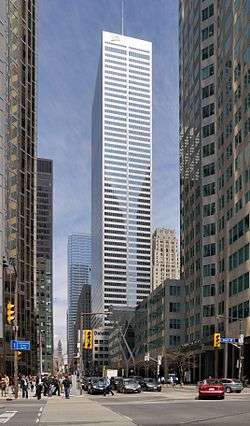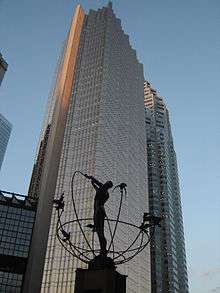Financial District, Toronto
| Financial District | |
|---|---|
|
View of skyscrapers in the financial district from the CN Tower |
The Financial District is a business district in Toronto, Ontario, Canada, within the downtown core. It was originally planned as New Town in 1796 as an extension of the Town of York (later the St. Lawrence Ward).[1] It is the main financial district in Toronto, and is the financial heart of Canada. It is bounded roughly by Queen Street West to the north, Yonge Street to the east, Front Street to the south, and University Avenue to the west, though many office towers in the downtown core are being constructed outside this area, which will extend the general boundaries. Examples of this trend are the Telus Tower and RBC Centre.
It is the most densely built-up area of Toronto, home to numerous banking companies, corporate headquarters, high-powered legal and accounting firms, insurance companies and stockbrokers. In turn, the presence of so many decision-makers has brought in advertising agencies and marketing companies. The banks have built large office towers, much of whose space is leased to these companies. The bank towers, and much else in Toronto's core, are connected by a system of underground walkways, known as PATH, which is lined with retail establishments making the area one of the most important shopping districts in Toronto. The vast majority of these stores are only open during weekdays during the business day when the financial district is populated. During the evenings and weekends, the walkways remain open but the area is almost deserted and most of the stores are closed.
It is estimated that 100,000 commuters enter and leave the financial district each working day. Transport links are centered on Union Station at the south end of the financial district, which is the hub of the GO Transit system that provides commuter rail and bus links to Toronto's suburbs.
Tallest buildings 140m+
| Name | Image | Height m / ft |
Floors | Year | Category | Notes |
|---|---|---|---|---|---|---|
| First Canadian Place |  |
298 / 978 | 72 | 1976 | Commercial |
|
| Scotia Plaza | 275 / 902 | 68 | 1988 | Commercial | ||
| Commerce Court |  |
239 / 784 | 57 | 1972 | Commercial | |
| Toronto-Dominion Centre | 223 / 731 | 56 | 1967 | Commercial | ||
| Royal Bank Plaza |  |
180 / 591 | 40 | 1979 | Commercial | [8][9] |
Major skyscrapers and complexes in the financial district include:
- First Canadian Place
- Scotia Plaza
- Brookfield Place
- Toronto-Dominion Centre
- Royal Bank Plaza
- Fairmont Royal York
- One King West
- Exchange Tower
- Commerce Court
- Sun Life Centre
- Trump International Hotel and Tower
- RBC Centre
- Bay Adelaide Centre
- Telus Tower
- Ritz-Carlton Toronto
Origins of Financial District

The district's origins date back to the mid to late-19th century when a number of early banks had head offices located in Toronto. Most of these banks were regional and came and went. It was not until the second half of the 20th Century that the Big Five banks located their headquarters there.
Of the big banks, only CIBC and Toronto-Dominion Bank (including the banks existing before mergers) had full head offices in Toronto:
- Canadian Imperial Bank of Commerce (CIBC) (1961) — both Imperial Bank of Canada (1875) and Canadian Bank of Commerce (1867) had head offices in Toronto
- Royal Bank of Canada (RBC) (1976) — relocated corporate head offices from Montreal; maintains legal head office in Montreal
- Bank of Montreal (BMO) (1975) — relocated corporate head offices from Montreal; maintains legal head office in Montreal
- Toronto-Dominion Bank (TD) (1955) — previous Bank of Toronto (1855) and The Dominion Bank (1869) had head offices in Toronto
- Scotiabank (1931) — relocated corporate head office from Halifax; maintains legal head office in Halifax
Business Improvement Area
The area is represented by the Toronto Financial District Business Improvement Area (BIA) that all commercial businesses in the area belong to. The organization engages in streetscape improvements, addressing key issues that impact the area, and promoting the area's businesses online.
Lost Historic Buildings
The construction of buildings in the district lead to the demolition of 19th and 20th Century buildings:
- Old Toronto Star Building - First Canadian Place
- retained various facades of 19th Century buildings along Yonge Street - Brookfield Place
- Bank of Toronto head office - Toronto-Dominion Centre
- The Dominion Bank head office - Commerce Court West tower
Diplomatic Missions and Trade agreements
- Consulate of Mexico
- Consulate General Of The Republic Of Korea-Commercial Section (KOTRA)
- Consulate General Of Japan
- Consulate Of Malaysia
- Consulate-General Of The Dominican Republic
- Taipei Economic & Cultural Office
- French Economic Commission
References
- ↑ Historical Atlas of Toronto, Derek Hayes, 2008, ISBN 978-1-55365-290-8, Pg 26
- ↑ "First Bank Tower". Emporis.com. Retrieved 2008-02-18.
- ↑ /?buildingID=34 "First Canadian Place" Check
|url=value (help). SkyscraperPage.com. Retrieved 2008-02-18. - ↑ "Scotia Plaza". Emporis.com. Retrieved 2008-02-18.
- ↑ "Scotia Plaza". SkyscraperPage.com. Retrieved 2008-02-18.
- ↑ "Toronto-Dominion Bank Tower". Emporis.com. Retrieved 2008-02-18.
- ↑ "Toronto-Dominion Bank Tower". SkyscraperPage.com. Retrieved 2008-02-18.
- ↑ "Royal Bank Plaza". Emporis.com. Retrieved 2008-02-18.
- ↑ "Royal Bank Plaza". SkyscraperPage.com. Retrieved 2008-02-18.
External links
| Wikimedia Commons has media related to Financial District, Toronto. |
 Toronto Entertainment and Financial Districts travel guide from Wikivoyage
Toronto Entertainment and Financial Districts travel guide from Wikivoyage- Bay Street Corridor neighbourhood profile
 |
Bay Street Corridor Discovery District |
 | ||
| Entertainment District Niagara |
|
Downtown Yonge St. Lawrence | ||
| ||||
| | ||||
| Railway Lands South Core |
